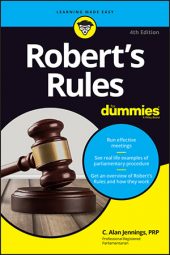After discussion begins, it’s too late, no matter how lousy the idea. You can’t stop it with this motion then; you can only kill the motion by moving to Postpone Indefinitely or by voting it down. In short, if you miss your chance to kill it by objecting to its consideration, you have to at least listen to the maker give his pitch because he’s entitled to recognition to speak first to his motion.
Objection to the Consideration of a Question can be applied only to an original main motion.
Objecting to Considering a Question
The following example isn’t the only situation in which this motion comes in handy, but it’s one of those common scenarios that lends itself to describing the motion’s use.If you’re an active member of an organization and you participate regularly in its meetings, you’ve no doubt encountered Stumpy Neverstops — you know, the guy who shows up at every meeting making the same motion that gets argued and finally voted down. Every meeting, Stumpy batters the hull of his ship. Every month, he persists in introducing his motion, trying to get the group to do something it just doesn’t want to do and isn’t likely to want to do anytime soon.
After a few meetings like this, you’re at your wit’s end. And there’s no end in sight because Robert’s Rules allows Stumpy to make his motion again at every new meeting, even if it failed at a previous meeting — and Stumpy knows no shame. Well, that can all end now. Here, you learn how to send Stumpy sailing around the reef in his lifeboat while you enjoy a calm sea for a change.
Objection initiated by a member
To use Objection to the Consideration of a Question, get to your feet quickly (hopefully as soon as the undesirable motion rolls over the lips of the person offering it) and say, “Mr. Chairman, I object to the consideration of the question.”Because this motion decides whether to summarily dismiss a motion without consideration, it doesn’t even need a second. The chair just responds with, “The member objects to the consideration of the motion. All in favor of considering the motion will rise. [pause] Opposed, rise. There are two-thirds opposed to considering the motion, and it will not be considered.” It’s all over, Stumpy. Sit down!
Finely tuned quick-draw skills help you any time you need to use Objection to the Consideration because it’s too late to object to consideration of a motion once debate has begun or if any subsidiary motion (except Lay on the Table) has been stated by the chair.
Objection initiated by the chair
If the chair has a good sense of members’ limits when it comes to likely intolerance for some motions, he may want to offer (on his own initiative) the members the opportunity to object by saying, “It is the sense of the chair that the consideration of this question may have objection. Shall the motion be placed before you for your consideration?”If a motion is outside the scope of the purposes of the organization, conflicts with the bylaws, or is otherwise deemed out of order to be considered, then objection to the consideration of the question is itself out of order. When this incidental motion is used incorrectly in this manner, it’s treated as a point of order, with the chair ruling the motion objected to as out of order.
6 key characteristics of the motion to Objection to the Consideration of a Question
The motion Objection to the Consideration of a Question- Can interrupt a speaker who has the floor (until debate has begun on the motion to which it is applied)
- Doesn’t need to be seconded
- Isn’t debatable
- Can’t be amended
- Requires a two-thirds vote against consideration to sustain the objection
- Can be reconsidered only if the objection is sustained

